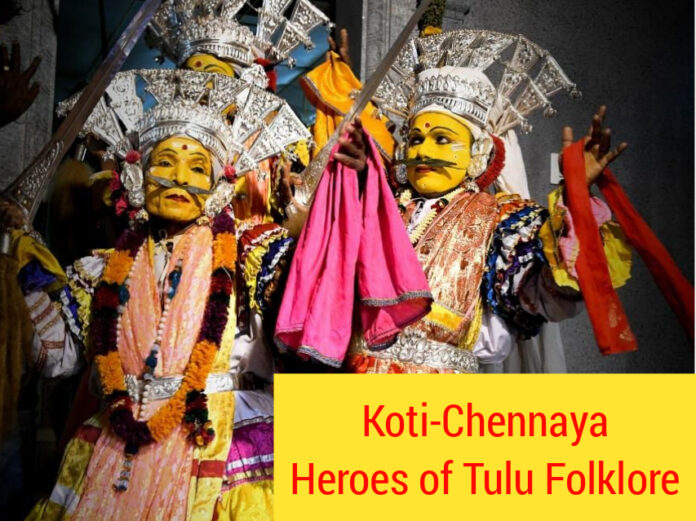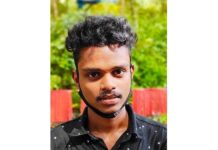This is Part V of the 14 part Koti- Chennaya series
Part IV Part III Part II Part I
[Note by the translator: The twin daivas(spirits) of Koti and Chennaya are one of the most popular folk deities of Tulunadu. Along with other daivas or bhutas such as Kallurti, Bobbarya, Maisandaya, Alibhuta, Koragajja, etc., Koti-Chennaya get venerated in the length and breadth of the Tulu region. Numerous studies suggest that most daivas are reminiscent of the folk heroes of that name, who were subjected to oppression of different sorts to maintain the hierarchical status-quo of the traditional Tulunadu. When they became mayaka (or perished fighting that oppression), they started getting venerated. Being born in the Billava¹ caste, Koti-Chennaya were subjected to constant treachery and harassment, even though they came close to power centres. It is roughly estimated that the twin brothers lived in the seventeenth or the eighteenth century. The following story of Koti and Chennaya is a translation based on the story written by Shri Panje Mangesha Rao, an early litterateur in Kannada. Panje himself got several (Tulu) versions of the story – one of them from Hermann Moegling of the Basel Mission. Comparing and contrasting, he finally arrived at the following story in the early twentieth century.]
Just as there was a Ballala for the Padumale territory, there was a Ballala for Panja[1] too. His name was Kemara Ballala. Panja was a big settlement then.
There was a double-storeyed house in Panja;In front of the house was a thatched courtyard.On the right, there was a coconut tree with a platform built neatly beneath it; on the left, there was a well with aneta instrument to draw water;a couple of cattle sheds at the back of the house; beside that, there was a fowl house. Koti-Chennaya reached the entrance and called out, “Payya! Payya!”
No one responded. Chennaya called out loudly again, “Oh Payya, Payya… Is he out?”
“Who’s calling?” a woman was heard asking.
Koti said, “We are just goers-by. Is Payya Baidya in the house?”
The woman replied “He isn’t there”.
“Where is he?”
“He has gone to Sankamale for toddy-tapping”
“When will he come?”
“If he goes in the morning, he returns in the afternoon; if he goes in the afternoon, he returns in the evening.”
“Is he about to come now?”
“He may come now. If you wear the thread (Brahmin), be seated on the platform; if you are a Vokkaliga, be seated in the thatched courtyard; if you belong to our caste, be seated in the swing in the veranda.”
Koti-Chennaya thought it was not appropriate to enter a house without the presence of the man of the house. So they settled in the courtyard and started chewing their Veelya. However, the betel nut was too strong for Chennaya. He felt giddy and drowsy. Koti asked for some water.
The woman of the house had said earlier that she would not come out when the man of the house was absent. But now, she had to present herself. She wore madi[2], went to the well and came back with a pitcher full of water.
By then Chennaya was normal and was wiping his sweat in his handkerchief. The woman kept the pitcher outside the threshold and stood behind the door. The brothers saw the pitcher but kept staring at each other without taking it for a drink. The woman saw this and said, “I have kept water for you”.
Koti said, “If we were to drink the water that you give, we need to know about your background”
“Oh, why not? But the story is long. My husband won’t come soon too”, the woman replied.
But she hardly knew that her husband was already there with his toddy, entering from the back door. He saw his wife talking to a stranger. He started eavesdropping!
Chennaya said, “Lets listen to the story”
Woman – “It seems my grandmother, i.e. my mother’s mother was a Brahmin. Since she
came of age before marriage, her parents could not transgress the existing practice – they blindfolded and left her in a forest.
Koti – “then?”
Woman – a man who had climbed the palm tree for tapping, informed about this girl to the
Ballala. As per Ballala’s order, the man took her to his house; looked after her well and married her off to one Birmana Baidya.
Koti – “Birmana Baidya of Kargola Thota[3]?”
Woman – “Yes, yes, Kargola Thota; I had forgotten the very name! Now I remember my
mother had mentioned it once.”
Koti – “Who is your mother?”
Woman – “My mother is the daughter of the same Birmana Baidya.”
Koti asked “What’s your mother’s name?
Woman – “Deyi”
Koti – “and father?”
Woman – “Kanthanna”
Koti – “Your native place?”
Woman – “I have heard it is Brahmara of Kemmalaje. But I have not been there.”
Koti – “How many children does your mother have?”
Woman – “I am told I was the first one. After me, she gave birth to twin boys in a closet in
beedu.”
Koti –Why should a woman of Kargola Thota deliver in beedu?
Woman – “That… I will tell you. You must know Perumaalu Ballala of Padumale. Once
when he went on a hunting expedition, he had a severe thorn prick. It was so acute that he thought he was going to die. Then, my mother was pregnant. In the hope that she would medicate it, she was called to the beedu. Disregarding the fact that she was carrying, mother prepared medicines herself by grinding the herbs and applying them on his body. Subsequently, she delivered twin boys in the beedu itself.
Koti – “What happened later?”
Woman – “She passed away three months after the delivery.”
Koti – “Was there nobody nearby during her death?”
Woman – “When I was seven years old, I was married off and was brought here. From then
on, I never left this place. Therefore, I have only heard the sweet news of my brothers’ birth or the bitter news of mother’s death; I have never seen either.”
Koti-Chennaya were full of excitement and anxiety at once. They were silent for a minute
staring at each other.
After a while Koti again asked, “Who brought those children up?”
Woman – “I had no interest in matters thereafter. For a woman, her native home should be
strong. After mother’s death, I didn’t go to my native place; haven’t seen my brothers. But the people of that village praise their valour…as though they are fire born of water; thunder born of earth…”
Chennaya – “Akka, what’s your name?”
Woman – “My name is Kinnidaru”.
At that moment Koti-Chennaya got up and prostrated to her saying “If there is any sister, it’s you! If there are any brothers, it’s we.” The husband of the woman, who was hiding behind the wall till then, came up and asked them to get up. He took them to the swinging seat on the veranda; Kinnidaru was speechless with happiness and excitement. She milked the cow and got fresh milk for her brothers. They were treated with all delicacies possible: jaggery payasam, eatables made of jackfruit, seasoning of ghee, curds, butter, pickle, white rice[4], etc. The eatables produced hunger even if one wasn’t hungry!
Kannada version by Shri Panje Mangesha Rao (“Koti Chennaya”, from Panjeyavara Kritigalu: Sanna Kathegalu mattu Kadambarigalu, Ed: Panje Ramaraya, Madras: Orient Longman Ltd, 1973)
Translated English version by Shashikantha Koudur (Professor in Humanities at National Institute of Technology Karnataka, Surathkal)
Glossary of Kannada and Tulu words
- At present, in Sullia Taluk of Dakshina Kannada district
- A cloth worn for the sake of purity
- Name of a place
- In Tulunadu, where boiled rice is used routinely, white rice is used on special and festive occasions.



























[…] Part V Part IV Part III Part II Part I […]